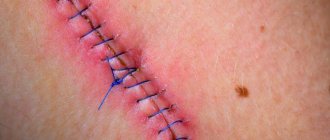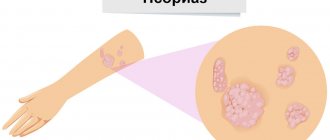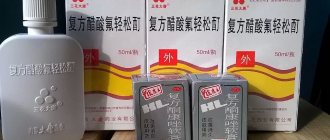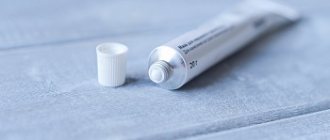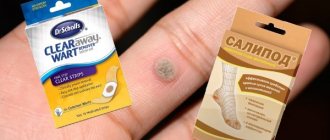Shoes are most often to blame for the appearance of calluses on the feet. New shoes rub the skin, and the high heels of women's shoes, together with thin soles that do not provide adequate shock absorption, plus an uncomfortable last, guarantee an excessive load on the skin and compression of the toes. This is how calluses appear.
Photo: https://binogi.ru/wp-content/uploads/2015/08/Plaster_from_corns_3-e1438585463443.jpg
Anti-callus patches
To speed up healing, you can use a special anti-callus patch:
- Compide - suitable for wet and dry corns, relieves pain, promotes rapid recovery;
- Leuko - disinfects, accelerates healing, prevents the penetration of bacteria;
- Salipod - softens keratinized tissue, suppresses inflammation, and has regenerating properties.
If the blister interferes with walking, and the patch does not reduce pain, then you should not wait for natural healing. In this case, it is necessary for the dropsy to burst. To do this, you need to carry out the following manipulation:
- disinfect the corns and nearby skin;
- make several punctures with a thin needle;
- let the liquid drain out, squeeze out the remaining residue with a dry cloth;
- Do not tear off the skin, but press it tightly to the wound and lubricate it with healing ointment (Levomekol, Bepanten).
httpv://www.youtube.com/watch?v=embed/_GOwpZT5Xc0
Fast Healing Products
There are many pharmaceutical and folk remedies that are recommended to be used to smear calluses for quick healing if the surface of the blister is damaged:
- “Rescuer” ensures rapid healing and protects against suppuration;
- “Synthomycin liniment” helps to heal a wound during an inflammatory process;
- Vishnevsky balm is used to quickly cure purulent pathology;
- If you anoint the affected area with 10% Salicylic ointment, the treatment of wet calluses will be accelerated;
- To quickly cure inflamed dropsy, Levomekol ointment is used;
- For faster healing, it is recommended to treat a callus that has torn with an oil tincture of the herb St. John's wort (pour a glass of raw material into 0.5 liters of any vegetable oil and leave in the dark for 3 weeks). The pathology is treated by applying a gauze bandage soaked in the composition to the problem area.
Before applying pharmaceutical products to broken calluses on your feet, you must carefully read the instructions and follow their recommendations.
Callus and then
While any person can “earn” a callus, for athletes and people in certain specialties this injury can be a “professional” injury.
For example, weightlifters have wet calluses on their palms over time turning into dry ones. In track and field athletes, football players and military personnel, calluses most often occur on the feet - in the heels, toes - and are associated with prolonged running or walking. The palms are a “weak” place in terms of the formation of wet and then dry calluses in people engaged in physically difficult work.
But, surprisingly, people who suffer from a lack of physical activity and avoid physical labor in principle are also at risk. This case is best characterized by folk wisdom: “A lazy person at work is a callus on the body.”
The vast majority of people do not consider callus a medical problem precisely because they know the cause of its appearance and the fact that it does not require active treatment. Nevertheless, it is possible and necessary to speed up the healing of calluses. What should I do for this?
Signs of infection and treatment options
The inflammatory process when pathogenic microorganisms enter the wound from a burst callus is characterized by the following symptoms:
- Painful redness around the callus;
- Tumor of the problem area;
- Increased temperature of the whole body;
- Suppuration of the wound surface.
How to anoint a burst callus:
- Cut the spines along the edges of the aloe leaf and peel off the skin from the concave side. Apply the fleshy part to the wound and apply a gauze bandage. It is advisable to do the procedure at night;
- Apply a piece of Kalanchoe leaf, after removing its skin, to the inflamed wound;
- Before going to bed, steam the affected heel or toe in a warm solution of potassium permanganate. Wipe your leg dry, apply a plantain leaf, and apply a sterile bandage on top.
First aid
A callus can appear on any part of the foot, but the heel is most often affected. How to quickly cure a callus that has burst on the heel:
- Remove the affected leg from shoes and clothing (socks, tights);
- Wash your hands with soap;
- Gently wash the area around the lesion with warm water and soap, being careful not to get any liquid into the wound;
- Treat the burst callus with any antiseptic (furatsilin solution, hydrogen peroxide, light pink solution of potassium permanganate);
- If the liquid inside the wound is free of blood, and the callus itself has not affected a large area of skin, you can fill the wound with BF-6 medical glue. The burning pain lasts literally 1-2 minutes. But then the wound is covered with a thin protective film, which prevents infection. A bactericidal patch should be glued on top of the treated surface;
- If the affected area is large, the wound should be smeared with antimicrobial ointment (Levomekol, Streptotsidovaya, Liniment synthomycin, etc.). Then it is recommended to apply a sterile bandage, which must be changed 2-3 times a day, while the ointment will protect the wound from infection by microbes and the bandage sticking.
Is it possible to smear calluses with brilliant green and iodine? This is of interest to patients who often develop dropsy. If you use the product on an open wound, you can get burned. In addition, the drugs greatly dry out delicate skin, causing cracks to appear on it.
If the surface of the dropsy is not broken, treatment is carried out using disinfecting compounds over the skin covering the wound. Zelenka protects it from inflammation. Potassium permanganate is used for daily baths, which speed up healing.
What to do if a callus on your foot bursts outside the home:
- Apply a plantain leaf to the wound with the glossy side, after washing or wiping it from dust and dirt. Put a sock on top;
- Pluck several carved yarrow leaves, chew them thoroughly until a homogeneous mass is obtained, and cover the wound with the resulting composition;
- If you don’t have familiar medicinal plants at hand, stick a leaf of birch, oak, poplar, or maple on the affected area;
- Remove the shoes that are rubbing your feet, otherwise the blister may break.
Arriving home, you should quickly and thoroughly treat the callus that has burst on the heel.
Treatment of dry old calluses
The main principle will be repeated steaming with gradual scraping with a pumice stone. Or, after softening in hot water with herbal infusions, with the addition of salts and oils, medicinal ointments are used for baths.
Photo: https://www.notizie.it/wp-content/uploads/2018/06/verruche-plantari.jpg
Traditional recipes help remove calluses:
- Onion skins soaked in vinegar. In the form of acid, it is kept for two weeks. Then dry and apply. But healthy skin around the area needs to be protected with greasy cream, Vaseline, lard or goose fat.
- Kalanchoe leaves with the outer skin removed. They are tied onto a pre-steamed callus. Then they scrape off what has softened and rub it with moisturizer.
- Indoor Crassula or Money Tree. Treat its leaves in the same way as Kalanchoe.
Beauty salons offer hardware removal. A special technique easily removes rough, dead epidermis. But such services are expensive, and there is always a risk of infection.
If treated correctly, they are removed without leaving any traces. But neglected, very outdated ones can lead to unpleasant and painful complications. And, of course, the best option would be to prevent the appearance of calluses.
New shoes should be worn together with socks until they take the shape of your feet. Flesh-colored patches are the most useful thing in your purse in case of scuff marks. Gel insoles also save you from discomfort.
Ways to prevent formations
Treating water callus is much more difficult than preventing its formation. To avoid rubbing dropsy, it is recommended to comply with the following requirements:
- It is advisable to break in new shoes using a special product to soften them;
- use “footprints” so that the heel does not rub;
- Don't put on shoes if your feet are wet.
The problem area should heal in no more than 2-3 weeks. For inflammation that lasts longer, the patient should visit a doctor (dermatologist, surgeon).
A wet callus, if it bursts, causes pain and discomfort to a person, so you should not delay treatment and a visit to the doctor. To prevent the development of a pathological process, if you notice increased friction, stick a piece of adhesive tape on the problem area. It is recommended to select shoes according to your foot size and wear them at the appropriate time according to weather conditions. Compliance with hygiene rules reduces damage to the feet by calluses.
How to get rid of callus at home
If for some reason it is not possible to contact a specialist, there are several methods for eliminating callus at home. All techniques are based on the initial softening of the corns and its subsequent mechanical removal.
For the first stage - softening - a patch with salicylic acid is most often used, which is glued to the problem area and then secured with a bandage or any other fixing agent. You need to wear the patch for several days, after which you can try to remove the callus core mechanically. If the “operation” is successful, the remaining indentation in the skin must be treated with iodine and sealed with a band-aid until complete healing.
If the problem was noticed in the early stages, then the removal of the callus will take place quickly and without much discomfort, but if the situation is advanced, then the first attempt to remove the rod may end unsuccessfully: the “cap” of the callus will be removed, but subsequent manipulations will be very painful.
Even taking into account the possibility of getting rid of callus on your own at home, in order to avoid complications, it is better to contact a qualified dermatologist.
What to do to get rid of the disease
Piercing
To prevent the rupture of a large bubble, the dropsy is punctured. They do this only if it itself can break through at any moment, and also causes severe pain and discomfort.
Before puncture, the subcutaneous bladder is disinfected. The instrument is disinfected along with the callus. Alcohol or hydrogen peroxide will do. They have an anti-inflammatory effect. You can replace alcohol with iodine. Use sterile medical needles or processed sewing needles. Alcohol or fire calcination are also used to sterilize needles.
The needle is held parallel to the water calluses, on the side. You cannot pierce from above. This will cause a deep wound and fundal irritation.
It should be pierced on the first day after the watery blister appears.
One or two punctures will help release the fluid from the bubble. They will ensure constant outflow. Care must be taken to ensure that the lower layers of the skin are not overexposed. The walls of the bladder are preserved. They will prevent the spread of infection.
Then a local antibiotic is applied to the water calluses. Use the dosage recommended by the doctor and apply a protective patch. Replacement with a new one is required twice a day. If the callus appears again, then the puncture is done again.
When water calluses rupture with detachment of the wall, anti-bacterial ointment is applied to the cleaned wound. Next, secure it with adhesive tape.
Doctors and traditional medicine do not advise making punctures on small formations. The bladder protects against infections.
Using soap and soda solution for baths
To speed up the healing of calluses on the foot, baths are used. Add one teaspoon of baking soda per liter of water. Four to five shavings of soap are cut into warm water. The duration of the procedure is 15-20 minutes. Until healing, it should be performed every day.
The second way to remove callus is to use potassium carbonate (potash). A solution of a crystalline substance of 10% per liter of water is also mixed with soap.
Removal with callus plaster
A ready-made preparation containing salicylic acid, rosin, paraffin and petrolatum will help get rid of the disease. It prevents contamination and the spread of infections. You can use propolis adhesive plaster. As a rule, the callus goes away on its own within 3-5 days.
Application of callus fluids
This is a combination medicine for removing water callus. Contains alcohol, collodion, brilliant green and salicylic acid. Apply after a hot bath for a week.
Following the advice of traditional medicine
- Aloe leaves. The bandage is applied as follows: the core is bandaged onto the water callus; the bandage should not be removed until the morning. After the bandage is removed, lubricate the sore spot with a nourishing cream.
- Grease with onion and garlic juice. Squeeze out the juice, mix and lubricate the calluses.
- Fresh potatoes. You need to rub it and apply the resulting pulp to the wound.
- A slice of lemon. The legs are steamed, lemon is applied and secured with a bandage. The bandage is kept on the foot until the morning.
Plants that can speed up the healing process: Robert's geranium, forest geranium, river grass, common oak, creeping tenacious, goat willow, meadow clover, large burdock, coltsfoot, roofing sapling, Euphorbia, Dandelion officinalis, large sedum, caustic sedum , Purple sedum, Greater celandine.
In general, therapy is aimed at softening the tissue. It will allow you to easily remove watery calluses. The keratolytic properties of the substances have a softening effect on the tissue of the bladder wall. Handy tools will help in removal.
If the callus does not go away and continues to bother you, you should consult a doctor. He will treat the opened bladder and recommend drug treatment.
Following the specialist’s recommendations will shorten the healing time of the callus. It is necessary to contact a surgeon and treat the affected areas. Often healing goes away on its own. In case of severe inflammation, it is removed surgically.
httpv://www.youtube.com/watch?v=embed/VWh8M9-as_A
Water calluses
They are often the first stage of dry. Formed on any areas of soft skin. But most of all at the base of the toes and hands, along the outer edge of the little fingers and big toes. But they cause much more pain and trouble. Water callus cannot be confused with any other. Visually, it looks like a bubble swollen on the skin, filled with exudate, clear as water.
Photo: https://bagiraclub.ru/images/bagiraclub/2017/11/v31.jpg
When touched, this water sac is elastic and easily moves in different directions. But he responds to every touch with sharp and burning pain. There is often a temptation to puncture the bladder and squeeze out the liquid from it so that everything heals faster and the pain stops. But this is not recommended. It is better to give blistered skin rest and time for natural recovery.
This is important because the clear liquid inside the wound is nothing more than lymph. It, like a barrier, separates dead skin and living tissue. It contains all the proteins, microelements and cellular substances necessary for recovery. The presence of lymph in the bladder shortens the recovery period for the rubbed area of skin.
Treatment of water calluses
But it happens that the friction continues, and the bubble itself bursts. In such situations, an extremely painful wound is formed. It must be treated with any antiseptics without alcohol. For example, an aqueous solution of Furacilin, Miramistin, pink weak potassium permanganate, Chlorhexidine, Povidone-iodine.
In general, stinks are much easier to treat than others. If the integrity of the bubble is not broken, you need to remove your shoes and wash the damaged area with laundry soap. If possible, it is better for the bubble to remain open. As a last resort, other shoes should not damage it. You cannot continue to wear the same pair that caused the wear, otherwise a bloody wound will appear in the same place.
Silicone pads and patches will help protect the damaged area from further friction. During natural recovery, you should not remove the skin remaining after the water callus, as it will still serve as protection for the delicate newborn skin underneath.
Self-deliverance
Pharmacies may offer a special cream for such cases. And at home it can be replaced by baths with infusions of calendula, yarrow or chamomile. Such herbs promote rapid healing. Dry ones will have to be treated patiently for a longer time. pre-steaming them in hot water.
If desired, softening herbs, soda or bath salts are added to the water. After softening the rough patch of skin, you can try to remove it with a pumice stone or a grater from a pedicure set. After separating the upper layer of skin, this area is lubricated with cream. If the dry callus does not disappear the first time, the procedure will have to be repeated every other day.
Very old calluses that have a core or have a large superficial growth of keratinized skin are very difficult to treat at home. Often, after consultation with a surgeon, they have to be operated on. The growths on the surface are cut off, and the roots are burned out with a laser or frozen with liquid nitrogen.
How to get rid of calluses at home
If the roots are not too deep, you can try home treatment:
- Hot baths with mustard and subsequent treatment with pumice. Approximately 4 procedures will be required.
- Propolis. A piece of lard is melted. Crushed propolis is added to the hot fat. After cooling, a cake of suitable size is formed from the mixture, which is fixed on the wound for 12 hours.
- Fresh celandine juice extracted from the stem of the plant. It is dripped onto a plaster and the previously steamed callus is sealed. Keep for 10 hours.
- A mixture of chopped onions and garlic, applied after steaming under a fastening bandage. Approximately 8 such compresses will be required.
Dry calluses, especially those recently acquired, are not so insidious. You can use them in a pedicure salon or do it at home, armed with a basin into which hot water with sea salt or infusions of sage, chamomile, and calendula are poured. When it has steamed, scrape it off layer by layer with pumice. Then rub in foot cream.
Orthopedic products
Often the cause of the formation of dry calluses and corns are problems treated by orthopedists. These are arthritis, flat feet and deformity.
Photo: https://ae01.alicdn.com/kf/HTB19ALwAfiSBuNkSnhJq6zDcpXae.jpg_q50.jpg
To correct the situation, experts in this profile recommend wearing:
- Subtarsal gel half insoles.
- Interdigital spacers.
- Sleeves and finger covers.
- Orthopedic shoes or special insoles.
Such goods are sold in specialized stores or made to individual measurements in orthopedic workshops.
Video:
Preventive action
The conditions for new wounds to appear are created by excessive friction and moisture. Synthetic socks and boots made of artificial, non-breathable materials create a greenhouse effect for the feet. What if the shoes are too small or too tight? the feet in it take the wrong position.
Water blisters appear on your hands when working with garden tools without gloves. If your hands are wet, contact with equipment all the more contributes to the appearance of pain and the red spot that precedes dropsy. If you stop working at this stage and start processing it, it is guaranteed not to appear.
To treat abrasions on the skin, use:
- Bread crumb soaked in a weak vinegar solution. It is applied at night.
- Aloe has a reputation as a healing plant. The spines and top layer of peel are removed from the thick and fleshy agave leaf. The jelly-like pulp is applied to the abrasion and secured with a bandage or fixed to the damaged area with a plaster.
- Grandma's recipes remind me of potato lotions. Grated raw tuber is used to line the area of abrasion and leave overnight under a fixing bandage.
- from the lemon , capturing a small part of the pulp. Apply for a couple of hours.
- Dandelion juice. Garden weed is also an excellent healer. Fresh juice is carefully applied to the painful redness and allowed to dry on the skin.
- Honey is a well-known natural antiseptic and an affordable aid in restoring damage. After lubrication, cover the sore spot with film until the morning.
- Calendula tincture or dried flowers infused in boiling water not only heal wounds, but also remove calluses. Apply as a compress with insulation for a couple of hours.
Excellent results are obtained by mixing several components. For example, take potatoes and onions along with aloe for a compress. The composition is not removed for 24 hours. After this, it is easily removed, its top layer itself lags behind the skin.
Treatment of calluses with traditional methods
Steaming the callus in a bath of warm water promotes rapid healing. For 3 liters you need to add 2 large spoons of baking soda and 1 - dried chamomile. Soak the foot in water for 10-15 minutes, spread it with Salicylic ointment, and seal it with a special plaster.
There are several ways to prevent the callus from becoming inflamed:
- Apply a cross-cut aloe leaf to the damaged area for 2-3 hours.
- Potato juice, which is applied as a lotion for 2 hours twice a day, relieves swelling, reduces pain and promotes healing.
- Propolis, added to baby cream in a ratio of 1:5, is applied to the wound, after which a bandage is applied. When using this method, an allergic reaction is possible, so during the first use you need to carefully monitor changes in skin condition.
How to get rid of a callus on the foot?
Corns on the feet are a common problem, the solution of which is made difficult by the constant load on this place while walking. If you do not take into account specialized creams, oils, ointments and plasters sold in any pharmacy, you can get rid of calluses on the feet using folk recipes.
For example, steaming the skin in a bath of hot water diluted with a strong chamomile decoction helps to cope with corns. It takes half an hour to soften the rough skin of the feet, after which the problem area should be thoroughly treated with pumice, wiped dry and lubricated with nourishing cream or fatty oil (olive, almond, sandalwood). To enhance the effect, you need to put on socks and take a horizontal position for a while so that the skin is moisturized and softened as much as possible.
It is important to remember that neither folk remedies nor pharmaceutical remedies for calluses will help if you continue to wear uncomfortable, tight shoes. Filed-off corns will simply return in a more severe form.
The corn has burst, what should I do?
If your dropsy suddenly bursts, you should wash your hands thoroughly and disinfect the edges of the wound with an antiseptic so that the product does not get on the opened area - this will slow down the healing process. Then cover the wound with adhesive tape.
After disinfection, broken wet calluses on the heels can be sealed with an anti-callus plaster. It absorbs excess lymph fluid without preventing air from entering the wound and the burst dropsy heals faster.
To obtain a positive effect, you need to correctly apply an anti-callus adhesive plaster to the burst blister on the heel:
- Using treated manicure scissors, cut off the dead edges of the skin;
- Wipe the wound with a cotton pad soaked in clean water, after which the wound must be wiped dry;
- stick the patch on and do not remove it. It will fall off on its own when the wound heals.
Attention! Without consulting a doctor, the patch is not recommended for use by people with diabetes. A wet callus has burst, but there is no band-aid? In this case, you can use pharmaceutical drugs that have antimicrobial and anti-inflammatory effects, and also have a healing effect
By following the instructions you can achieve a positive result
A wet callus has burst, but there is no band-aid? In this case, you can use pharmaceutical drugs that have antimicrobial and anti-inflammatory effects, and also have a healing effect. By following the instructions, you can achieve a positive result.
What to do if a callus on your foot bursts
Wet (water) calluses often appear on the soles of the feet, especially in the summer. Rubbing dropsy is quite simple: small pebbles or sand get into the gap between the skin and the shoes. As a result, a watery layer is formed between the layers of the epidermis, swollen with a bubble. You should not allow the dropsy to burst prematurely, since the “water” that fills it has bactericidal properties. It protects the nascent young skin from inflammatory processes and pathogenic microorganisms. But what to do if a callus bursts on your foot? To answer this question, you need to know how to treat burst calluses to avoid infection.
A burst callus can cause a lot of trouble due to the resulting pain and the possibility of inflammation, and then suppuration due to infection at the site where the integrity of the vesicle is broken. Quickly healing a burst callus means preventing the onset of the inflammatory process.
What types of calluses can there be on the heels?
A callus or callus is a compacted area of skin with sharply defined boundaries, causing pain, which is formed as a result of long-term contact with a mechanical irritant. On the heels, it most often occurs upon contact with shoes.
The appearance of calluses can also be caused by factors such as excessive sweating on the feet, improper foot care and poor footwear. There are people who have an innate tendency to form calluses. They have a low subcutaneous fiber content, which leads to the appearance of calluses even with slight friction.
- Bone - a formation that appears as a result of bone renewal after injury, during the natural process of healing of a fracture. Forms at the site of injury in the form of a connective tissue scar;
- Spurs or calluses;
- Skin - is formed through prolonged exposure to an irritant on the skin and happens:
- wet (dropsy or soft callus);
- hard or dry (corns);
- pointed.
Dropsy is a blister that forms under the top layer of skin and is filled with fluid (lymph). It can also be bloody - filled with blood and purulent, containing pus. Causes pain and discomfort, but does not pose a threat to life. However, when neglected, it can become a source of infection for the entire body.
If mechanical impact continues on the dropsy, it may acquire a hard (dry) appearance.
Hard calluses or corns occur on the heels due to constant pressure. It is implicit, so it does not cause discomfort. At the point of contact, the skin becomes rough, forming a keratinized layer of epithelium. It doesn't hurt and hardly bothers me. However, in an advanced stage, it begins to crack and these cracks spread to healthy areas of the skin, and then severe pain is felt.
A pointed or core callus has a hard rod in the center that grows deeply into the lower layers of the epidermis, causing severe pain when walking. If you do nothing, then over time it will become deeply rooted, and its surface will crack, the pain will become unbearable and will greatly complicate life.
Read more about the treatment of dry calluses with a core in this article.
Why do calluses appear?
Friction, pressure and wet skin are three key factors that are guaranteed to lead to calluses.
On a vulnerable area of the skin, under the influence of friction and/or pressure, a blister filled with liquid appears - a callus. The fluid may be clear or mixed with blood; this happens when the blood vessels at the site of the callus are located close to the surface. However, calluses do not appear everywhere and not always. The likelihood of such an injury increases significantly if the area of skin affected is wet.
The purpose of one of the studies, the results of which were published in the official journal of the International Society of Biophysics and Skin Imaging, was to find ways to prevent the appearance of calluses. Scientists have experimentally found that increased hydration of the skin surface (excessive moisture) increases the rate of change in skin temperature in response to the application of force (pressure, friction) and, therefore, increases the likelihood of the formation of wet calluses.
In the vast majority of cases, the callus does not require specific treatment and disappears on its own within 1-2 weeks (provided that the injured area of skin is not subjected to repeated damaging effects). But in some cases, medical assistance may still be needed, for example, when the callus is extensive, located in an inconvenient place and greatly interferes with everyday life.
If the callus is opened, an infection has entered the wound and an active inflammatory process has begun, medical care is required.
Main symptoms
The main manifestations are pain and difficulty walking.
Constant pressure leads to redness of the skin, swelling, and noticeable pain. A subcutaneous bubble forms. It fills with clear body fluid. The walls are tense.
When damaged, the water callus opens and fluid flows out. An opened watery callus can lead to severe inflammation. In some cases, abscesses form - purulent infections. They can develop in subcutaneous tissue, muscles, bones, and organs.
Tearing of the bladder wall increases the risk of contracting a staph or streptococcal infection. This is evidenced by larger redness, pain without friction, additional yellowish formations, pus, and increased temperature. Treatment depends on the stage of development.


